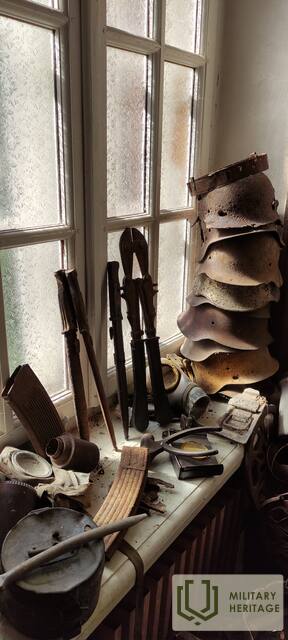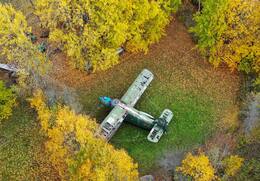About the found war artifacts
In modern Latvia, the collections of various museums are also supplemented by the personal collections of private individuals, which are often publicly exhibited and are available to everyone. Many people have a hobby of old things, including items related to military history. Often, visitors have no idea about the origin of these things. Did they suddenly appear? In all cases, it is the work of several years and an interesting, personal story about one person's interests in collecting things in order to create, for example, a museum from them. The narrator describes his personal experience, giving the reader an idea of the situation in Latvia after World War II. The legacy left by various armies and the lack of necessary raw materials on the farm force people to find creative ways to use practically anything in order to survive. Over time, what is useless on the farm becomes valuable, historical exhibits that tell the story of the experience of Latvia and its people.
“As far as I know, after the war, only light artillery and a machine gun were scattered around our area. A Russian 45mm anti-tank gun with the bolt removed was in the bushes by the roadside until 1960 or a little longer. Also, a “Maksis” (K.Š. Maxim system machine gun) stood in the bushes by the lakeside, I saw it myself as a child, the pioneers dragged it away for scrap. There was also another one, one of the uncles collected it and buried it somewhere near the house. A classmate and his godfather unsuccessfully searched for an “MG” (K.Š. Domāts German machine gun), which the godfather had buried 40 years ago. After the reclamation, the situation changed.
I know that there was a pond in that field near the house where the Russian hospital was located. The ponds were filled with the weapons of the wounded and the dead. After the land reclamation, the pond was filled in and the houses were demolished. It no longer has a place in life.
After the battles of the summer of 1944, a truckload of fallen “plinths” (K.Š. Domāti weapons) was collected near Steķi and taken to Jēkabpils. The truck did not reach its final destination, disappearing with the driver and the Cheka lieutenant who had been traveling with it. Until the 1990s, the militia and the Cheka tried to find out if anyone had heard anything about the case. Around 1995, I learned that the engine of that truck was probably in some house. Unfortunately, it was heavy and the nearest museum was not interested in buying it. Scrap collectors bought the engine from the aunt for 10 lats. All the witnesses died without telling anyone.
The planes that crashed during the war were scrapped by the Germans. Likewise, the Russian abandoned cannons in 1941. I have heard that one digger found such pieces of “pushki” (K.Š. Domats cannon) with a metal detector. Some pieces of the German “T-4” tank might still be lying along the drainage ditches on my side. The Germans shot down a Russian IL-2 (K.Š. Red Army attack aircraft) after a successful battle with four “T-34” (K.Š. Red Army tank) and two “SU-76” (K.Š. Red Army self-propelled artillery installation). I have still seen some large pieces of iron from that battle lying around in the surrounding farms. Mostly everything has been scrapped. Even today, a “T-34” without a turret stands under one of the roads. The place is swampy, they tore down the tower, dragged it to the collective farm workshops, but covered the bottom with gravel when they repaired the road. The tower's armor made excellent splitting axes. I bought one of those from local scrap metal buyers.
The warplanes and tanks that were still lying around after the war had already been removed by the collective farm scrap collectors in my time. Only pieces of aircraft duralumin sheet metal were left lying around, which the locals used as a tool. A classmate's grandfather, for example, had made window shutters. I bought them back from a classmate later with a cross.
The blacksmith collected all the iron, it was a money-making business for him, he forged everything on a donkey and turned it into useful household items. The man died without using up all his supplies. So various tank wheels, pieces of chains and armor were left standing. The same applied to soldiers' helmets - the insides were torn out (K.Š. Domāts internal helmet shock absorption insert) and used on the farm. While searching the site of the former ryāja, where German prisoners of war were held during the war, a local found various German army awards.
Local villagers told me that when there was no electricity at the school after the war, the children's fathers decided to solve the problem. They dug up the engine of a German army car, which they had buried during the war and later used for the school. During the war, one of the fathers had thrown steel spikes on the road and a German truck ran over them while retreating. All the tires were flat and the "Fritz" left the diaper on the side of the road. At night, the engine was removed and buried. Then, after several years, it was put to work and for seven years the school ran a power generator. Nowadays, people are ready to buy all these things, but in the past, it was all thrown around the surrounding houses, forests and roadsides like unnecessary junk. It had only practical value - an object that could be remade, improved and used on the farm.
Related timeline
Related objects
Cafe “Dakota” and exposition of military vehicles and equipment
Cafe Dakota is located in Ogre municipality, Ciemupe, on the A6 highway. The exhibit on military heritage allows its owner to combine his hobby and interest in military history with his business of running a cafe. Here you can enjoy a meal and see military equipment, weapons, soldier equipment and aircraft from the end of the 20th century. The exhibit is available to cafe visitors during working hours. Tours are available only in Russian and prior registration is required.
Kurzeme fortress museum in Zante
Will be open from May 1st.








